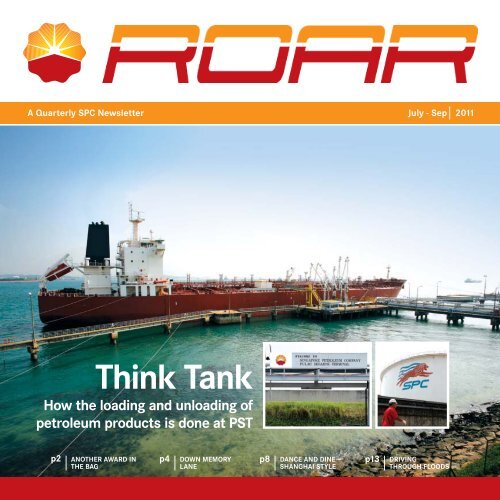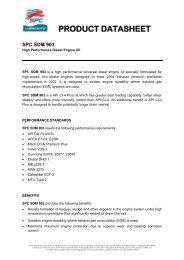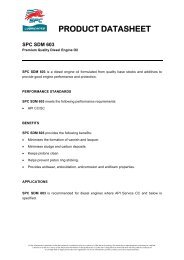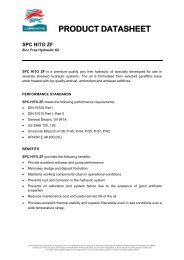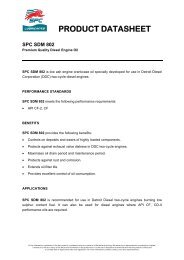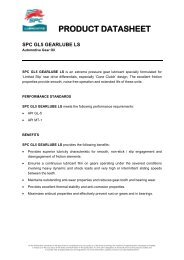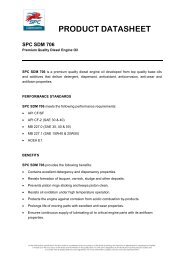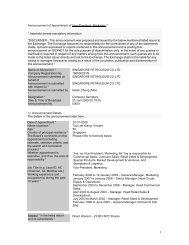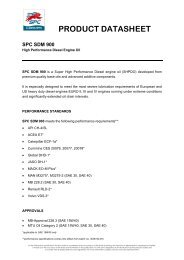Roar - SPC
Roar - SPC
Roar - SPC
You also want an ePaper? Increase the reach of your titles
YUMPU automatically turns print PDFs into web optimized ePapers that Google loves.
A Quarterly <strong>SPC</strong> Newsletter<br />
July - Sep 2011<br />
Think Tank<br />
How the loading and unloading of<br />
petroleum products is done at PST<br />
p2<br />
ANOTHER AWARD IN<br />
THE BAG<br />
p4<br />
DOWN MEMORY<br />
LANE<br />
p8 DANCE AND DINE –<br />
SHANGHAI STYLE<br />
p13<br />
DRIVING<br />
THROUGH FLOODS
A Quarterly <strong>SPC</strong> Newsletter<br />
Jul - Sep 2011<br />
Another Award in the Bag<br />
By Sharon Tan, Corporate Communications<br />
Editorial<br />
Courtesy of DP Information Group<br />
The Group held its first Dinner and Dance (D&D) this August. A<br />
happy occasion combined with the Long Service Awards, it was a<br />
night of wining and dining, with plenty of fun thrown in between.<br />
Mrs Patsy Wong, one of this year’s Long Service Award recipients,<br />
is <strong>SPC</strong>’s longest-serving employee – with an impressive 40 years of<br />
service. In this issue of <strong>Roar</strong>, we take a look at Mrs Wong’s journey<br />
in <strong>SPC</strong>.<br />
and be aware of the global economic challenges surrounding us<br />
today. From imminent threats like the downgrade of the US credit<br />
rating to the debt crisis in Europe to the fear of a global recession,<br />
it is clear that we are now operating in challenging times. We<br />
must, therefore, continue to motivate ourselves, work together<br />
as one integrated team to overcome any business and economic<br />
challenges, and seize any value-adding opportunities for the Group.<br />
Mr Xia Hongwei, Managing Director of PCSG, receiving the award from Mr Teo Eng Cheong, Chief Executive Officer of IE.<br />
For the first time ever, PetroChina International (Singapore) Pte. Ltd.<br />
(PCSG) received the Fastest Growing 50 (FG50) Award – a distinctive<br />
honour accorded to Singapore’s 50 fastest-growing companies for<br />
2011. Mr Xia Hongwei, the Managing Director of PCSG, was on hand<br />
to receive the award at the ceremony.<br />
Receiving this award shows the industry’s recognition of PCSG’s<br />
efforts of developing and growing the company in Singapore. Since<br />
its inception, PCSG has gradually built up the trading business and<br />
established itself as one of the largest trading houses in the Asia-<br />
Pacific region. Today, the Group has businesses in trading, processing,<br />
marketing and exploration.<br />
The (FG50) Award ranks Singapore’s top 50 companies that have<br />
attained the highest three-year Compounded Annual Growth Rate<br />
(CAGR), and includes all currently ranked Singapore 1000 and SME<br />
1000 companies.<br />
The FG50 Awards ceremony is organised by DP Information Group<br />
(DP Info), with Ernst & Young Solutions LLP; and supported by the<br />
Accounting and Corporate Regulatory Authority (ACRA), Infocomm<br />
Development Authority of Singapore (IDA), International Enterprise<br />
Singapore (IE), SPRING Singapore (SPRING), the Singapore Business<br />
Federation (SBF) and The Business Times.<br />
As we express our appreciation to those who have served with the<br />
company for more than five years, we would also like to welcome<br />
our newcomers. Besides learning about the company through the<br />
sharing sessions by the various departments, the new members<br />
of the <strong>SPC</strong> family also visited Jurong Bulk Plant, Pulau Sebarok<br />
Terminal (PST) and a service station.<br />
Our cover story in this issue sheds some light on what goes on<br />
behind the scenes at PST. While many of our colleagues have some<br />
common knowledge on PST’s operations, we take this opportunity<br />
to share the painstaking tasks that our colleagues stationed at PST<br />
undertake daily.<br />
As mentioned during the D&D, the Group has had a good financial<br />
performance to date. However, it is important for us to also reflect<br />
I am confident that together with our dedication, commitment<br />
and hard work, we will be able to ride through all these difficulties<br />
together and achieve greater performance for our company.<br />
Foo Jang See<br />
Senior Vice President,<br />
Refining, Crude Supply Trading & Operations<br />
2<br />
3
A Quarterly <strong>SPC</strong> Newsletter<br />
Jul - Sep 2011<br />
Down Memory Lane<br />
By Sharon Tan, Corporate Communications<br />
The date 1 September 1971 is special to Mrs Patsy Wong as it marked<br />
her first day of work at <strong>SPC</strong>. Forty years later and now ready for her<br />
retirement, she is <strong>SPC</strong>’s longest-serving employee. In her words, “I<br />
have given my entire youth, as well as my loyal and dedicated services<br />
to one company for four decades – which is indeed a very long time!”<br />
Since her initial days with <strong>SPC</strong>, Mrs Wong had indeed gone through<br />
a lot with the company as its secretary, and enjoyed a very fulfilling<br />
career. She even moved with the company for a total of four times<br />
(imagine all that packing and unpacking)! Throughout her four decades<br />
in <strong>SPC</strong>, she supported five out of the company’s seven CEOs.<br />
been lunch partners for a staggering 34 years<br />
– and have gone from being mere colleagues<br />
to lifelong friends.<br />
Mrs Wong retired on 15 September 2011<br />
– and it is now time for her to savour the<br />
next phase of life. Besides minding the<br />
domestic homefront (she has been jokingly<br />
nominated the “Minister of Home Affairs” by Mr Wong),<br />
Mrs Wong is also looking forward to catching up with her personal interests<br />
and doing some travelling.<br />
Thanks for your 26 years (including<br />
15 years during my tenure as CEO) of<br />
loyal and dedicated service in <strong>SPC</strong>! It has<br />
been a wonderful and happy experience<br />
working with you. May you enjoy<br />
happiness and good health in your welldeserved<br />
retirement!<br />
- Mr Cheng Hong Kok, <strong>SPC</strong> CEO,<br />
1981 to 1996<br />
Mrs Wong and her husband Mr Darrell Wong<br />
– then and now.<br />
Mrs Wong<br />
with her best<br />
friend in <strong>SPC</strong>,<br />
Mrs Lisa Tan.<br />
In fact, she was able to witness the many corporate structural<br />
changes, and the comings and goings of top-ranking leaders at <strong>SPC</strong>.<br />
She also weathered the storms with <strong>SPC</strong> – going through times when<br />
the company faced many challenges and struggles during the downcycle<br />
periods in the petroleum industry.<br />
Mrs Wong shared that her most memorable moment during her tenure<br />
was the <strong>SPC</strong> bowling tournament at Jackie’s Bowl in Orchard. Everyone<br />
was bowling when an announcement was made over the bowling<br />
centre’s announcement system to inform former CEO and now Senior<br />
Advisor, Mr Koh Ban Heng to go to the hospital, as Mr Koh’s wife was<br />
about to give birth to their first-born child very soon. Everyone erupted<br />
into cheers and applause upon hearing the happy news.<br />
Needless to say, to have worked in the same company for 40 years<br />
is no easy feat. When asked if she had any advice for her colleagues,<br />
Mrs Wong encouraged all to continue to work hard, work smart, and<br />
get along with your superiors and colleagues.<br />
Given that Mrs Wong had worked in <strong>SPC</strong> since her youth, it came as<br />
no surprise that she met her husband, Mr Darrell Wong, in <strong>SPC</strong> too.<br />
Mr Wong was then an Internal Auditor with <strong>SPC</strong> from 1973 to 1975.<br />
Now, the couple has two grown-up children, and can both enjoy their<br />
golden years.<br />
Besides finding love in <strong>SPC</strong>, Mrs Wong has also found a best friend<br />
in Mrs Lisa Tan from the marketing department. Both of them have<br />
Patsy is a very reliable and<br />
efficient secretary who works well<br />
with staff of all levels. I wish her<br />
a very happy retirement and good<br />
health. Patsy, my very best wishes<br />
to you and your family with the<br />
Lord’s blessings.<br />
- Mr Koh Ban Heng, Senior<br />
Advisor, <strong>SPC</strong> CEO, 2003 to 2011<br />
Mrs Patsy Wong receiving her Long Service Awards through the years.<br />
It is truly remarkable that you have spent<br />
your entire career with one company, and that<br />
your tenure spanned four decades. You were<br />
there during <strong>SPC</strong>’s humble beginnings, and<br />
remained to see it grow to what it is today.<br />
My association with you was the shortest<br />
among the CEOs that you’ve worked with.<br />
Nevertheless, without you I would have been<br />
totally lost. Those small measures of progress<br />
we achieved would have been impossible<br />
without your help. I have occasionally<br />
remarked afterwards, that a certain individual<br />
in Singapore has set the highest standard of<br />
professionalism and courtesy in his or her<br />
field. That individual was none other than you.<br />
Now, I hope you’ll enter a different phase of<br />
your life with the enthusiasm that you have<br />
always been known for.<br />
- Mr Thomas Shiah, <strong>SPC</strong> CEO, 1996 to 1997<br />
4<br />
5
A Quarterly <strong>SPC</strong> Newsletter<br />
Jul - Sep 2011<br />
How the loading and<br />
unloading of petroleum<br />
products is done at PST<br />
By Sharon Tan, Corporate Communications<br />
While many of us have common knowledge of the operations at Pulau<br />
Sebarok Terminal (PST), <strong>SPC</strong>’s offshore oil storage terminal, we may not<br />
know the processes that our colleagues go through to load or unload oil<br />
from tankers and barges. With guidance from the PST crew, I made a trip<br />
to PST during a discharge operation to find out more. Each shift at PST<br />
consists of three staff – a supervisor and two technicians, and outsourced<br />
mooring crew. During his shift, each technician is based either at the jetties<br />
or tank farm.<br />
What happens in the control room<br />
The duty supervisor in the control room is the main liaison point for the<br />
vessels, surveyors and vessel agents. His duties are as follows:<br />
a) Lining up the terminal system for receiving cargo<br />
b) Liaising with the cargo officer on the progressive quantity of oil received,<br />
as well as the unloading rate and manifold pressure<br />
c) Preparing all official documents such as Bill of Lading, Certificate of<br />
Quantity, Cargo Manifest, Certificate of Origin and operations time sheet<br />
d) Liaising with the vessel agent for the arranging of the PSA pilot and tug<br />
boats for the berthing and un-berthing of the vessel<br />
Berthing the tanker at PST jetty<br />
The tanker’s size makes it hard to berth at a jetty. During berthing, the<br />
tanker is controlled through helm movements and tug assistance. Two<br />
PSA tugboats help by pushing the tanker in the right direction where<br />
necessary. The berthing and un-berthing maneuvers require knowledge and<br />
skills among the tanker crew, PST technicians and PSA pilot – and great<br />
teamwork with rope-runners and the mooring party.<br />
Securing the tanker<br />
• This requires coordination between the mooring crew and the tanker<br />
crew. From berthing to fully securing the vessel, this whole process may<br />
take up to one hour.<br />
• The bowline and sternline prevent the tanker from going forward and<br />
backward, while the springline and breastline stop the tanker from<br />
moving outwards.<br />
• The cables and ropes from the tanker are pulled ashore using a capstan<br />
(Picture 3), a vertical-axled machine, which rotates and pulls the cables<br />
– so that the crew can hook it to the mooring bollard.<br />
Picture 2: The different<br />
mooring lines that control the<br />
movement of the vessel.<br />
Picture 1: A diagram showing<br />
the terminology of the different<br />
cables and ropes.<br />
Picture 3: The<br />
capstan makes<br />
work easier, as it<br />
rotates and pulls<br />
the cables and<br />
ropes. Workers are<br />
spared the arduous<br />
task of manually<br />
pulling the ropes<br />
themselves.<br />
Conducting operational meeting and safety checks<br />
• The PST technician will go onboard the tanker to conduct these<br />
operational and safety checks:<br />
- Checking the availability of fire hoses and emergency-towing ropes.<br />
- Ensuring that any unused manifolds are securely blinded off (refer to<br />
Picture 4).<br />
- Making sure that the scuppers (an opening at deck level that allows<br />
ocean or rainwater drain off) are plugged (Picture 5). This ensures that<br />
any oil spill will be contained onboard.<br />
- Inspecting the cleanliness of the main deck – with no oil spills and<br />
that emergency-escape routes are not obstructed.<br />
- Conducting pre-discharge meetings with the vessel cargo officer and<br />
other officers to complete the Ship/Shore Safety Checklist.<br />
Taking of oil samples<br />
A surveyor will go onboard the tanker with the PST technician to take<br />
samples of the oil from all the cargo tanks using a zone sampler (refer<br />
to Picture 6). A laboratory report will be generated to determine the<br />
adherence to the contracted fuel-quality specification. These samples will<br />
be kept for three months before being disposed. In the event any dispute<br />
should arise, these samples would be required for testing and verification.<br />
After three months, the samples will be poured back into the PST fuel oil<br />
storage tanks.<br />
Picture 6: A zone sampler is used to draw oil samples from the cargo<br />
tank at the upper, middle and lower levels of the oil.<br />
Determining the oil quantity in the ship cargo tanks<br />
• Another surveyor will also be onboard to measure the oil level in the<br />
cargo tanks, using a gauging tape to record the oil temperature (Picture<br />
7). When lowered, the gauge will extend downward into the tank. Once<br />
the gauging tape reaches the oil, it will emit a constant beeping sound.<br />
• The gauging tape measures the distance from a reference point at the<br />
deck to the point where it first reaches the oil. This measurement is<br />
recorded, after which the surveyor will use it to read off from the tank<br />
calibration table and determine the quantity of oil in the cargo tanks.<br />
The measurements (also known as the “tank dip”) and temperature are<br />
recorded for all cargo tanks on the tanker.<br />
• To detect the presence of free water, the gauging tape is extended to the<br />
bottom of the cargo tank. An erratic beeping sound will be heard if free<br />
water is detected.<br />
• The PST technician will have to be present to bear witness to this<br />
process. The measured quantity of oil is then compared against the<br />
quantity indicated in the load port’s Bill of Lading.<br />
The start of unloading<br />
The mooring crew and the ship crew will connect the loading arms at the PST<br />
jetty to the ship manifold. As the size of the manifold and the loading arm<br />
may be different, a reducer will be fitted onto the manifold to accommodate<br />
the size difference (Picture 8).<br />
Once the pre-discharge meeting is conducted, and the sampling, checking<br />
and paperwork processes are completed, the vessel can then commence<br />
to unload the oil into the storage tanks at PST. The time taken to unload<br />
the vessel depends on the oil quantity and the pumping rate of the vessel.<br />
Picture 8: Loading arms at PST connecting to the manifolds<br />
on the vessel.<br />
During unloading<br />
While unloading is in progress, the PST technician and ship crew will<br />
regularly monitor the mooring ropes, and will tighten or loosen them<br />
according to the changes in tidal conditions and the vessel freeboard.<br />
The technician will also regularly check critical areas (such as the<br />
seafront and jetty area) for any possible leakages and spillages. After<br />
unloading, the surveyor and PST technician will check the tanker’s cargo<br />
tanks to ensure that they are empty (for full discharge) or do a tank dip<br />
(for partial discharge) before retrieving the loading arms and releasing<br />
the vessel. The processes of loading oil from PST to a vessel are similar,<br />
though some above-mentioned processes are carried out only after the<br />
vessel is loaded.<br />
At the tank farm<br />
The duties of the technician at the tank farm include measuring the level<br />
and temperature of the oil tanks, taking oil samples with the surveyor<br />
before and after the vessel unloads, and draining water from the oil tank<br />
if necessary.<br />
The transfer of oil from vessel to terminal (and vice versa) is by no means<br />
an easy task. As the terminal deals with highly flammable products,<br />
taking precaution against fires and explosions, as well as the safety of<br />
all personnel working at the terminal, are of the utmost importance at<br />
all times. This has been an enlightening trip for me.<br />
• About four shackles of cable are used for each mooring point. It is also<br />
preferable (depending on length of the tanker), to achieve a reasonable<br />
spread between the mooring points. These cables and ropes – bowline,<br />
springline, breastline and sternline (Pictures 1 and 2) – then help to<br />
control the movement of the vessel.<br />
Picture 4: Unused manifolds should<br />
be securely blinded off.<br />
Picture 5: Scuppers are<br />
plugged to prevent any oil spill<br />
into the sea.<br />
Picture 7: The gauging tape<br />
measures the distance from a<br />
reference point on the deck to<br />
the point where it first reaches<br />
the oil.<br />
6<br />
7
A Quarterly <strong>SPC</strong> Newsletter<br />
Jul - Sep 2011<br />
Dance and Dine – Shanghai Style<br />
By Jolyn Chong, Human Resource<br />
The members of the Recreational Committee who organised the D&D.<br />
12 August 2011 was a day that many of my colleagues had been<br />
looking forward to. On that day, more than 200 employees<br />
from PCSG and <strong>SPC</strong>, along with their partners, attended the<br />
first-ever combined Dinner & Dance (D&D) at Pan Pacific<br />
Hotel Singapore. Many employees arrived in style, dressing<br />
themselves up to the theme of “Shanghai Royale Night”.<br />
The early birds were entertained by a multitude of pre-dinner<br />
activities. Many colleagues were seen holding their own<br />
caricatures, paper fans with Chinese calligraphy and photo<br />
cards that had been customised to the theme.<br />
The evening kicked off officially when the Managing Director of PCSG, Mr Xia Hongwei,<br />
gave a welcome speech. Mr Xia took the opportunity to share the company’s financial<br />
results for the first half of the year, and its plans for the future. He also cautioned all of<br />
the recent global economic challenges, urging everyone to work together to ride through<br />
difficulties and achieve a greater performance for the company.<br />
For the first time ever, the Long Service Award (LSA) ceremony was held together with D&D. A total<br />
of 31 LSA recipients received their awards from Mr Xia and Executive Vice President, Mr Adam Xiong.<br />
One such award recipient is Mrs Patsy Wong. With an impressive 40 years of service, Mrs Wong is the<br />
longest-serving employee in the Singapore office. Read more about her on page 4.<br />
8<br />
9
A Quarterly <strong>SPC</strong> Newsletter<br />
Jul - Sep 2011<br />
The D&D was filled with many games and laughter – with the<br />
emcee entertaining everyone present with his jokes and vocal<br />
prowess. In fact, he even managed to engage the employees<br />
both onstage and offstage with games and a mass dance.<br />
Finally, the night was rounded off by the lucky draw that many<br />
were waiting for. It was indeed a memorable evening, and one<br />
where all the staff members thoroughly enjoyed themselves.<br />
We would like to extend our thanks to the members of the<br />
Recreational Committee for this well-organised and enjoyable<br />
event, which would not be possible without their hard work<br />
and effort. Here’s to the next one!<br />
The recipients of the Long Service Awards<br />
40YEARS<br />
35YEARS<br />
Orientation<br />
Programme<br />
2011 – A Warm<br />
Welcome<br />
By Gan Dong Lee, Human Resource<br />
Presentations<br />
at level 26’s<br />
conference<br />
room.<br />
For four mornings from 13 to 16 September, 38 new<br />
employees from PCSG, <strong>SPC</strong> and COSG attended an<br />
Orientation Programme.<br />
Lucky winners are presented with their prizes<br />
20YEARS<br />
The programme is designed to help newcomers gain<br />
an understanding and appreciation of the company’s<br />
various business and service functions – and to meet<br />
leaders from the respective business units.<br />
During the programme, presenters from the<br />
departments like Refining, Crude Supply Trading<br />
& Operations, Products Trading, Exploration &<br />
Production, Chemical & Special Products and<br />
Marketing shared insights on their operations and<br />
management structures. The new employees were<br />
also taken through the specific service roles of<br />
departments such as Health Safety & Environment,<br />
Human Resource, Risk, Legal, Finance and IT.<br />
Managing Director/Chairman & President,<br />
Mr Xia Hongwei with new employees.<br />
Learning about operations at<br />
Jurong East Service Station.<br />
15YEARS<br />
10YEARS<br />
In addition to the presentations, the group went on<br />
site visits to Jurong East Service Station, Jurong Bulk<br />
Plant and Pulau Sebarok Terminal (PST) to get firsthand<br />
experience of the operations in these facilities,<br />
and meet the colleagues stationed in these off-site<br />
offices. During the visit to PST, the group even had<br />
their first encounter with fire-fighting training.<br />
The site visit to Pulau Sebarok<br />
Terminal.<br />
5YEARS<br />
We would like to take this chance to thank all the<br />
presenters and off-site hosts for taking time off their<br />
busy schedules to orientate our new employees. Let<br />
us all extend a warm welcome to our new colleagues!<br />
Going through the drills of fire fighting.<br />
Sharing a light moment at PST.<br />
10<br />
11
A Quarterly <strong>SPC</strong> Newsletter<br />
Jul - Sep 2011<br />
The <strong>SPC</strong>-MH<br />
team with the<br />
land owners of<br />
Bantuas Village,<br />
at Palaran<br />
District Office.<br />
Driving Through Floods<br />
By Kevin Siak, Marketing<br />
The <strong>SPC</strong>-MH team with the land owners at Sambutan Sub District Office.<br />
The proposed plan to drill two onshore commitment wells at Samarinda<br />
by <strong>SPC</strong> Mahakam Hilir Pte. Ltd. (<strong>SPC</strong>-MH) is going ahead on schedule.<br />
As the preparation for the drilling continues, <strong>SPC</strong>-MH has successfully<br />
acquired land to construct two well-pads, and access roads for the Naga<br />
Utara and Naga Selatan wells.<br />
The acquired lands are located at Bantuas and Sambutan villages at<br />
Samarinda City in East Kalimantan. Residents had agreed to receive<br />
compensation in return for releasing some parts of their land to <strong>SPC</strong>-<br />
MH. Instead of taking the planned four months, the <strong>SPC</strong> land acquisition<br />
team was able to complete the acquisition in three months. Hence, <strong>SPC</strong>-<br />
MH would like to thank all parties for their assistance in this project –<br />
The Next Phase<br />
of Oil & Gas<br />
Exploration in<br />
Indonesia<br />
By Soekoesen Soemarinda, <strong>SPC</strong> Mahakam Hilir Pte. Ltd.<br />
especially <strong>SPC</strong> management from Jakarta and Singapore, the Bantuas<br />
and Sambutan neighbourhoods’ Chairman, Lurah (the urban village head),<br />
Camat (the sub-district head) and the land owners.<br />
The compensation documentation and releasing of property rights for the<br />
Bantuas and Sambutan villages were completed on 23 and 24 August<br />
2011 respectively.<br />
Throughout the project, <strong>SPC</strong>-MH had also embarked on different<br />
programmes – such as the building of facilities in the affected villages,<br />
which it believes will benefit the local citizens. It also continues to<br />
cooperate with all parties to ensure a successful drilling project.<br />
Flash floods have been occurring in Singapore recently. What<br />
may appear as a heavy downpour can suddenly turn into a<br />
flash flood that catches many people by surprise. As with<br />
all driving emergencies, prevention is better than cure. In<br />
such situations, listening to the radio for the latest flooding<br />
announcements and avoiding these affected areas can help<br />
you avert the situation. But what do you do if you are caught<br />
in a flash flood?<br />
The first thing to remember is: if you can help it, do not<br />
drive through flooded areas – even if it looks shallow<br />
enough to cross. Instead, seek alternative routes. Here<br />
are the reasons why you shouldn’t:<br />
1<br />
About<br />
2<br />
About<br />
3<br />
About<br />
4<br />
Roads<br />
5<br />
Dislodged<br />
6<br />
Floodwaters<br />
15cm of water will reach the bottom of<br />
most passenger cars, causing a loss of vehicle<br />
control and possible stalling.<br />
30cm of water will cause many vehicles<br />
to float away.<br />
60cm of gushing water can carry away most<br />
vehicles – including SUVs and MPVs.<br />
under severe flooding may weaken and<br />
give way under the weight of the vehicle.<br />
objects such as pieces of the kerb,<br />
tree stumps or other flood debris can smash into,<br />
damage and immobilise your car.<br />
can cover concealed potholes,<br />
which you may run a risk of getting stuck into<br />
during the flood.<br />
In the unlikely event that you encounter floodwaters<br />
and have to drive through it, consider the following:<br />
1<br />
Drive<br />
2<br />
Do<br />
3<br />
If<br />
4<br />
5<br />
If<br />
6<br />
If<br />
on the centre of the road. The water level would be the lowest in the<br />
middle, as the edges of the road slope on both sides to drain off water.<br />
your best to estimate the height of the floodwaters by observing the<br />
road signs and kerbs. Stop driving if the water reaches 15cm, when the<br />
water level is higher than the centre of your tyre, or if it reaches up to the<br />
exhaust pipe.<br />
you are driving through floodwaters, drive slowly in low gear. This is to<br />
keep the engine speed (rpm) high so that water is not sucked back into the<br />
exhaust. People who drive manual cars should shift into the lowest gear<br />
and go through the water gently, and at a constant speed. Those who drive<br />
automatic cars should shift into “L” mode or mode “1”.<br />
If possible, follow the path of the car in front.<br />
an approaching vehicle is driving quickly towards you, slow down and<br />
turn slightly away to deflect the waves from hitting your car directly. The<br />
waves created by the other vehicle may enter your vehicle’s air intake at<br />
the front, hence “drowning” your engine.<br />
your car stalls in floodwaters, this means water has most likely entered<br />
its engine compartment. Try not to restart the car, as it could cause further<br />
damage to the engine. Get out of the vehicle and go to higher ground.<br />
If you are able to drive out of the flood, the first thing you should do is to dry<br />
your brakes by using your foot to lightly pump the brakes while driving slowly.<br />
This dries the brake pads, thus ensuring braking efficiency.<br />
As part of your regular maintenance routine, do keep your tyres properly inflated,<br />
and your lights and wipers in good working condition at all times for a safe drive.<br />
12<br />
13
A Quarterly <strong>SPC</strong> Newsletter<br />
Jul - Sep 2011<br />
Bollywood<br />
Veggies<br />
HSE Quiz<br />
Award<br />
Winners<br />
In conjunction with HQ’s Safety Month in June, our HSE team conducted a HSE Quiz. Winners of the<br />
quiz were presented with petrol vouchers by Executive Vice President, Mr Adam Xiong.<br />
This year’s Green Day<br />
was held at Bollywood<br />
Veggies on 9 July, Saturday.<br />
Colleagues attended the<br />
Green Day with their family<br />
members, and were treated<br />
to a tour of the farm, many<br />
games and good food.<br />
Food<br />
Distribution<br />
As part of the corporate<br />
volunteer programme,<br />
some colleagues<br />
joined in the packing<br />
and distribution of<br />
food bags for the<br />
needy at the Redhill<br />
area. The Corporate<br />
Communications team<br />
will continue to look at<br />
more opportunities for<br />
such volunteer activities.<br />
14<br />
15
Editorial:<br />
Corporate Communications<br />
Contributors in this issue:<br />
Sharon Tan, Corporate Communications<br />
Jolyn Chong, Human Resource<br />
Gan Dong Lee, Human Resource<br />
Kevin Siak, Marketing<br />
Soekoesen Soemarinda, <strong>SPC</strong> Mahakam Hilir Pte. Ltd.<br />
PetroChina International (S) Pte. Ltd.<br />
Singapore Petroleum Company Limited<br />
One Temasek Avenue #27-00, Millenia Tower, Singapore 039192<br />
Tel : 6276 6006, Fax : 6275 6006<br />
www.spc.com.sg<br />
MICA (P) 038/09/2011 Co. Reg No: 196900291N<br />
This publication is printed on paper that is friendly to the environment.


